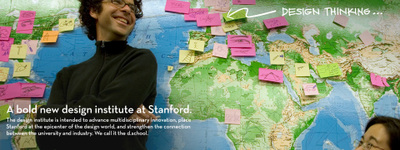Author Archives: Diego Rodriguez
Constraints
Two weeks ago I posted a quote from architect Joshua Prince-Ramus concerning the role of constraints in the process of design, and their relation to the end goal of creating innovative, highly appropriate solutions.
In response, my friend Scott emailed me this cool bit about Charles Eames talking about constraints in the design process (I turned off the comments feature on this blog due to the volume of inappropriate, abusive, and just plain dumb content being left behind. The upside is that I’m getting some thoughtful emails. Change is good). Here’s the Eames bit from Scott:
I liked Charles Eames’s piece "Design Q&A" so much I found a text
version somewhere and kept it. This part is perhaps the best:Q. Does the creation of design admit constraint?
A. Design depends largely on constraints.
Q. What constraints?
A. The sum of all constraints. Here is one of the few effective keys to the design problem-the ability of the designer to recognize as many of the constraints as possible-his willingness and enthusiasm for working within these constraints-the constraints of price, of size, of strength, balance, of surface, of time, etc.; each problem has its own peculiar list.
Q. Does design obey laws?
A. Aren’t constraints enough?
Stanford Student? Sign up for Creating Infectious Action
If you are a graduate student with masters standing at Stanford, you should think about signing up for Creating Infectious Action, a course to be taught by Bob Sutton and yours truly at the Stanford d.school starting in April. We’ll use design thinking to explore how to turn ideas into more than action — into infectious action!
There’s an application involved, of course:
Creating Infectious Action Application
Not everyone who signs up will be accepted, but it’s worth a try. Why not be one of The 24?
Please follow the directions in the application, particularly when it comes to turning the application in. If you email it to me instead of to the appropriate destination, it will get lost in the ether and you and I will be severely bummed.
Zen, The Don, and the PRO
Talk about viral — if you have an Internet connection and you haven’t yet seen the Microsoft I-pod PRO 2005 XP spoof video, then you’re probably living on Mars (do they have broadband there?).
Garr Reynolds, whose blog Presentation Zen is one of my favorites, put together this brilliant post linking Donald Norman’s idea of visceral design with the I-pod PRO 2005 to give us a great lesson in visual design.
Quality
I just ran across a website containing photos of a 1968 trip which became the subject of Robert Pirsig’s book Zen and the Art of Motorcycle Maintenance:
What a memory jogger. I first read the book as part of a class I took at Stanford with the great teacher and design thinker Jim Adams. It was a mechanical engineering class called, quite simply, "Quality". No six sigma here, no sir. Instead, we looked at old tractors, Japanese flutes, wrenches… and generally spent a lot of time getting a visceral feel for quality. The two textbooks for the course really shaped my few of the world as a design thinker, and continue to do so. The first was the formidable work The Nature and Art of Workmanship, by David Pye, the other Pirsig’s book.
If you haven’t read Zen, I highly recommend it. It’s a deep, chewy book, full of meditations on what makes good stuff, and what it means to live with good stuff and what it takes to keep good stuff being good stuff. Here’s a representative passage:
Each machine has its own, unique personality which probably could be
defined as the intuitive sum total of everything you know and feel
about it. This personality constantly changes, usually for the worse,
but sometimes surprisingly for the better, and it is this personality
that is the real object of motorcycle maintenance. The new ones start
out as good-looking strangers and, depending on how they are treated,
degenerate rapidly into bad-acting grouches or even cripples, or else
turn into healthy, good-natured, long-lasting friends.
Quality is one of those intangibles which is really difficult — maybe even pointless — to articulate verbally, but which is essential to be able to feel and recognize and act upon.
Happiness helps you innovate
Here’s my latest column for BusinessWeek Online. On happiness.
How does that saying go? If you look like your column photo, you’re too ill to write?
Open Innovation on Google Video
Not many speakers yet, but those that are there are notable; this could get interesting. Relative to the traditional model of conferences and speakers, this is certainly a disruptive approach.
On Tangible Brand Mantras, part 2
A while back I wrote about BMW’s initiative to build a "new" 1972 2002tii, a tangible brand mantra, from original parts. This is a very pure form of brand building which comes from a position of strength: if you got it, it ain’t braggin’. Flaunt it.
Honda has it, too. That’s why this stunning commercial, called Impossible Dream, is in fact an exercise in tangible brand mantras. They’re simply reminding us of all their soulful technical achievements. Here’s more about the making of the commercial. Turn up the volume, and smile.
He’s blogging
metacool Thought of the Day
‘We’re seeing constraints as opportunities. It’s not like we’re getting around the constraints. We’re saying, "The project’s just the constraints." If we can solve the constraints, that’s where the form will come, that’s where the beauty will come, that’s where the logic will come. And more likely than not, you can get it built, you can get it financed, you can get it on budget.’
– Joshua Prince-Ramus
photo via flickr





